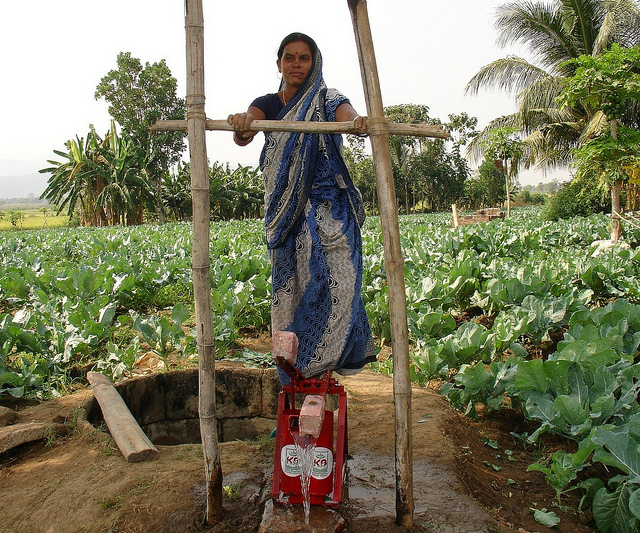Opinion: What Will It Take to Bring a Second Green Revolution to India?

LUDHIANA, India, Jul 15 (IPS) - Long-term agricultural growth in India is slowing down. The lands that saw remarkable increases in productivity in the 1970s and 80s, thanks to the technology rolled out as part of the first "Green Revolution", are not yielding the same results today.
India still has the second highest number of undernourished people in the world. To confront this problem, Prime Minister Narendra Modi has called for a Second Green Revolution on Indian soils. But what does this mean and what will it take to make this happen?3
The challenges Indian agriculture faces today are vastly more complex than those it faced 40 years ago. The technologies used in the first Green Revolution involved improved high yielding varieties of rice and wheat, irrigation, fertilisers, and pesticides.
But an increasingly varied climate and mismanagement of agricultural inputs are changing the agricultural landscape. Our Second Green Revolution needs to be refreshed to match this new complexity.
A data driven approach is going to be key. Sophisticated technology is now being developed to equip farmers with the information they need to protect their harvests in the face of scarce water and soil degradation.
So farmers in the North Indian states of Punjab and Haryana, who have access to the new tools like the Leaf Colour Chart and the handheld GreenSeeker optical sensor, can analyse the health of their crops, and apply the right amount of nitrogen to the soil to boost production of cereals like rice and wheat.
Land can also be levelled into a flat service, using last controlled devices that are mounted on tractors, to help farmers save up to 30 percent of water.
A considered plan for fertiliser use is also going to be essential. Just like humans, soils need a balanced diet of the right kind of nutrients in order to be healthy, a fact which has been overlooked by government subsidy programmes that only favoured urea for a long time.
The right kind of nutrients for the specific soil area needs to be applied, at the right rate, at the right time and in the right place for optimal soil health - we call this the 4Rs or nutrient stewardship. Modi's call to reopen fertiliser plants in Sindri and Gorakhpur, and open new ones in West Bengal must take into account this need for a "smart" approach, and make optimal use of key inputs such as fertiliser.
We cannot feed India, or indeed the world, without mineral (man-made) fertilisers. Although the debate has raged for many years pitting organic and mineral fertilisers against one another, science tells us that there is no conflict between these nutrient sources; quite the contrary, their use is complementary.
Mineral fertilisers actually increase soil organic matter content as a result of the greater root growth you get when crop yields improve. For example, over a 25-year period in Punjab, where mineral fertilisers have been consistently applied, soil organic carbon content rose by 38 percent.
Fertilisers also encourage enhanced microbial activity – a process that is vital for the long-term productivity of the soil and its ability to process nutrients. The effects are even greater when mineral and organic fertilisers are used together.
More research into technologies like these, that will help farmers make the most efficient use of scarce resources, whilst leaving minimal impact on the environment should be an essential element of India's Second Green Revolution.
Investment in rural infrastructure, improving market access and credit facilities will all need to be considered in conjunction with this. We cannot expect smallholders to take on new technologies without ensuring they can afford to use them, and get their increased amount of produce to market.
South Asia has long been a champion in the field of microfinance, that enables the rural poor to get access to credit and vital inputs like seed and fertiliser. Indeed, the 2015 World Food Prize Laureate, Sir Fazle Hasan Abed of BRAC in Bangladesh, has been awarded this prestigious prize for recognising that the poorest need an entire package of interventions in order to graduate to a sustainable livelihood.
Improved technologies must be distributed hand in hand with financing to buy them, training on how to use them, and encouragement to join farmer co-operatives and savings groups, both to improve their social standing and increase their bargaining power when selling their crops on. Without these supporting interventions, upcoming technologies cannot succeed.
The first Green Revolution did its job in an unprecedented way, averting a disastrous famine and preventing millions from going hungry. Now, we need an equally weighty intervention fit for the complexities of the 21st century, and India could lead the way.
As one of the most populous nations, with a high percentage working in agriculture, the time is now. If we follow these steps diligently, a Second Green Revolution for India is not out of reach.
Edited by Kitty Stapp
© Inter Press Service (2015) — All Rights ReservedOriginal source: Inter Press Service
 Global Issues
Global Issues